Hans Hofmann
Jump to navigation
Jump to search
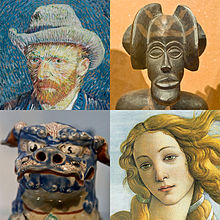
Hans Hofmann (21 March 1880 – 17 February 1966) was one of the older abstract expressionist painters working in New York. Hofmann originally came from Germany where he experienced the new art and so he connected European with modern American abstract art. He had strong influence as an art-teacher and writer on the younger American abstract artists after 1940.
Quotes[edit]

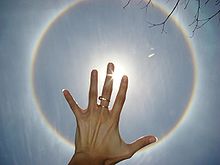
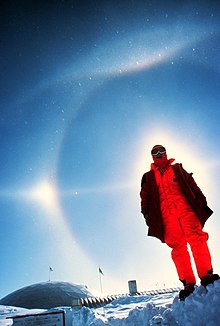
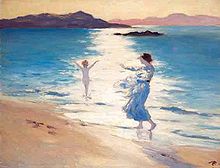


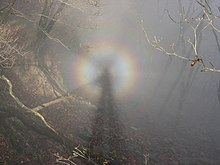
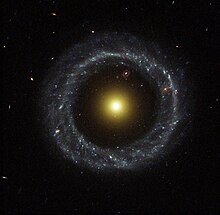
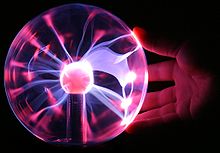
1940s[edit]
Search for the Real and Other Essays (1948)[edit]
- Quotes from: Search for the Real and Other Essays (1948) by Hans Hofmann, ed. Sara T. Weeks and Bartlett H. Hayes, Jr. Addison Gallery of American Art; (using M.I.T. Press edition (1967); (Partial online PDF)


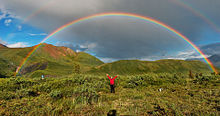



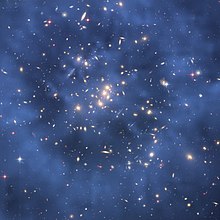
- Art is magic. So say the surrealists. But how is it magic? In its metaphysical development? Or does some final transformation culminate in a magic reality? In truth, the latter is impossible without the former. If creation is not magic, the outcome cannot be magic. To worship the product and ignore its development leads to dilettantism and reaction. Art cannot result from sophisticated, frivolous, or superficial effects.
- 'Search for the Real in the Visual Arts', p. 40
- The significance of a work of art is determined then by the quality of its growth. This involves intangible forces inherent in the process of development. Although these forces are surreal (that is, their nature is something beyond physical reality), they, nevertheless, depend on a physical carrier. The physical carrier (commonly painting or sculpture) is the medium of expression of the Surreal. Thus, an idea is communicable only when the surreal is converted into material terms. The artist’s technical problem is how to transform the material with which he works back into the sphere of the spirit.
- 'Search for the Real in the Visual Arts', p. 40
- This two-way transformation proceeds from metaphysical perceptions, for metaphysics is the search for the essential nature of reality. And so artistic creation is the metamorphosis of the external physical aspects of a thing into a self-sustaining spiritual reality. Such is the magic act which takes place continuously in the development of a work of art. On this and only on this is creation based.
- 'Search for the Real in the Visual Arts', p. 40
- A thought that has found a plastic expression must continue to expand in keeping with its own plastic idiom. A plastic idea must be expressed with plastic means just as a musical idea is expressed with musical means, or a literary idea with verbal means. Neither music nor literature are wholly translatable into other art forms; and so a plastic art cannot be created through a superimposed literary meaning. The artist who attempts to do so produces nothing more than a show-booth. He contents himself with visual story-telling. He subjects himself to a mechanistic kind of thinking which disintegrates into fragments.
- 'Search for the Real in the Visual Arts', p. 40-46
- The relative meaning of two physical facts in an emotionally controlled relation always creates the phenomenon of a third fact of a higher order, just as two musical sounds, heard simultaneously create the phenomenon of a third, fourth or fifth. The nature of this higher third is non-physical. In a sense it is magic. Each such phenomenon always overshadows the material qualities and the limited meaning of the basic factors from which it has sprung. For this reason Art expresses the highest quality of the spirit when it is surreal in nature; or, in terms of the visual arts, when it is of a surreal plastic nature.
- 'Search for the Real in the Visual Arts', p. 41
- A glimpse heavenward at a constellation or even at a single star only suggests infinity; actually our vision is limited. We cannot perceive unlimited space; it is immeasurable. The universe, as we know it through our visual experience, is limited. It first came into existence with the formation of matter, and will end with the complete dissolution of matter.
- 'Search for the Real in the Visual Arts', p. 43
- Depth, in a pictorial, plastic sense, is not created by the arrangement of objects one after another toward a vanishing point, in the sense of the Renaissance perspective, but on the contrary (and in absolute denial of this doctrine) by the creation of forces in the sense of push and pull. Nor is depth created by tonal gradation (another doctrine of the academician which, at its culmination, degraded the use of color to a mere function of expressing dark and light).
- 'Search for the Real in the Visual Arts', p. 44
- Since one cannot create 'depth' by carving a hole in the picture, and since one should not attempt to create the illusion of depth by tonal gradation, depth as a plastic reality must be two dimensions in a formal sense as well in the sense of color. 'Depth' is not created on a flat surface as an illusion, but as a plastic reality. The nature of the picture plane makes it possible to achieve depth without destroying the two-dimensional essence of the picture plane. .A plane is a fragment in the architecture of space. When a number of planes are opposed one to another, a spatial effect results. A plane functions in the same manner as the walls of a building.. .Planes organized within a picture create the pictorial space of its composition.. .The old masters were plane-consciousness. This makes their pictures restful as well as vital...
- 'Search for the Real in the Visual Arts', p. 44
- A line cannot control pictorial space absolutely. A line may flow freely in and out space, but cannot independently create the phenomenon of push and pull necessary to plastic creation. Push and pull are expanding and contracting forces which are activated by carriers in visual motion. Planes are the most important carriers, lines and points less so.. .the picture plane reacts automatically in the opposite direction to the stimulus received; thus action continues as long as it receives stimulus in the creative process. Push answers with pull and pull with push. ... At the end of his life and the height of his capacity Cézanne understood color as a force of push and pull. In his pictures he created an enormous sense of volume, breathing, pulsating, expanding, contracting through his use of colors.
- 'Search for the Real in the Visual Arts', p. 44
- Just as counterpoint and harmony follow their own laws, and differ in rhythm and movement, both formal tensions and color tensions have a development of their own in accordance with the inherent laws from which they are separately derived. Both, however, aim toward the realization of the same image. And both deal with the depth problem.
- 'Search for the Real in the Visual Arts', p. 45
- The reciprocal relation of color to color produces a phenomenon of a more mysterious order. This new phenomenon is psychological. A high sensitivity is necessary in order to expand color into the sphere of the surreal without losing creative ground. Color stimulates certain moods in us. It awakens joy or fear in accordance with its figuration. In fact, the whole world, as we experience it visually, comes to us through the mystic realm of color. Our entire being is nourished by it. This mystic quality of color should likewise find expression in a work of art.
- 'Search for the Real in the Visual Arts', p. 45
- One must realize that, apart from considerations of color and form, there are two fundamentally different ways of regarding a medium of expression: one is based on taste only — an approach in which the external physical elements of expression are merely pleasingly arranged. This way results in decoration with no spiritual reaction. Arrangement is not art. The second way is based on the artist’s power of empathy, to feel the intrinsic qualities of the medium of expression. Through these qualities the medium comes to life.. .In this life, an intuitive artist discovers the emotive and vital substance which makes a work of art.
- 'Search for the Real in the Visual Arts', p. 46
- It is the greatest injustice done to Mondrian that people who are plastically blind see only decorative design instead of the plastic perfection which characterizes his work. The whole De Stijl group from which Mondrian's art was derived must be considered a protest against such blindness.
- 'Search for the Real in the Visual Arts', p. 47
- The physical carrier is overshadowed by a relation. The relation creates an overtone. The physical carrier is absorbed by this overtone. The overtone spontaneously transforms the means of creation into a spiritual reality. The mystery of creation is then revealed.
- 'Search for the Real in the Visual Arts', p. 49
- The knowledge of reality, achieved by means of the complete sensory equipment, must be expressed artistically in terms of a medium which appeals to the memory of all sensory experience — but only through the eye.
- 'Search for the Real in the Visual Arts', p. 54
- The creative process lies not in imitating, but in paralleling nature — translating the impulse received from nature into the medium of expression, thus vitalizing this medium. The picture should be alive, the statue should be alive, and every work of art should be alive.
- 'Painting and Culture' p. 55
- Art leads to a more profound concept of life, because art itself is a profound expression of feeling. The artist is born, and art is the expression of his overflowing soul. Because his soul is rich, he cares comparatively little about the superficial necessities of the material world; he sublimates the pressure of material affairs in an artistic experience.
- 'Painting and Culture' p. 56
- Art is something absolute, something positive, which gives power just as food gives power.
While creative science is a mental food, art is the satisfaction of the soul.- 'Painting and Culture' p. 56
- It takes intelligence and training, self-discipline and fine-sensibility, to gain renewed life through leisure occupation. America now suffers spiritual poverty, and art must become more fully American life before her leisure can become culture.
- 'Painting and Culture' p. 56
- The general misunderstanding of a work of art is often due to the fact that the key to its spiritual content and technical means is missed. Unless the observer is trained to a certain degree in the artistic idiom, he is apt to search for things which have little to do with the aesthetic content of a picture. He is likely to look for pure representational values when the emphasis is really upon music-like relationships.
- 'Painting and Culture' p. 56
- Everything rhythmically organic is true. Everything, which results from the proper feeling for rhythmically organized spiritual units, is true and alive — alive within itself. When we lose the sense for such true beauty we lose our natural sense for the rich flavor of life, which is the basis for all inspirational work.
Things generally taken for beautiful are nothing other than the product of frozen, stereotyped taste, bound by sterile rules and purely exterior judgment.- 'Painting and Culture' p. 57
- The difference between the arts arises because of the difference in the nature of the mediums of expression and the emphasis induced by the nature of each medium. Each means of expression has its own order of being, its own units.
- 'Painting and Culture' p. 57
- Speech has arisen through the need for expression. Certain factors have contributed to making it the paramount utilitarian method of expression. There are ideas and things expressible in words, but there are ideas better expressed in music, the person with no musical ear, or without discipline in the language of music, lacks the key to the door of the world of musical experience. But we live in a world of volume and space; it is hard to conceive of the person who is space-blind or volume-deaf. The great majority of people have the means of approach to plastic beauty as part of their natural equipment. The teacher can develop this natural endowment as Necessity, the greatest teacher, has developed speech.
- 'Painting and Culture' p. 57
- There is a world of visual beauty open to the one willing to undergo the practice and striving necessary to the understanding of its language.
This world is a important as culturally as is the world of words or of music. My ideal is to form and to paint as Schubert sings his songs and as Beethoven creates his world in sounds. That is to say, creation of one’s own inner world through the same human and artistic discipline.
An inner sensation can find external expression only through spiritual realization.- 'Painting and Culture' p. 58
- When the impulses which stir us to profound emotion are integrated with the medium of expression, every interview of the soul may become art. This is contingent upon mastery of the medium.
- 'Painting and Culture' p. 58
- The impulse of nature, fused through the personality of the artist by laws arising from the particular nature of the medium, produces the rhythm and the personal expression of a work. Then the life of the composition becomes a spiritual unity.
- 'Painting and Culture' p. 58
- A work of art is a world in itself reflecting senses and emotions of the artist's world.
Just as a flower, by virtue of its existence as a complete organism is both ornamental and self-sufficient as to color, form, and texture, so art, because of its singular existence is more than mere ornament.- 'Excerpts from the Teaching of Hans Hofmann', p. 59
- The encompassing, creative mind recognizes no boundaries. The mind has ever brought new spheres under its control.
All our experiences culminate in the perception of the universe as a whole, with man as its center.- 'Excerpts from the Teaching of Hans Hofmann', p. 61
- Dreams and reality are united in our imagination. The artist possesses the means to create only after he has effective command of his faculty of empathy which he must develop simultaneously with his imaginative capacity.
- 'Excerpts from the Teaching of Hans Hofmann', p. 61
- It makes no difference whether a work is naturalistic or abstract; every visual expression follows the same fundamental laws.
- 'Excerpts from the Teaching of Hans Hofmann', p. 61
- Each expression-medium has a life of its own. Regulated by certain laws, it can be mastered only by intuition during the act of creating. It is in the nature of the laws which govern every expression medium that two separate entities, related through empathy, always produce a higher third of a purely spiritual nature. This spiritual third manifests itself as a quality which carries emotional content. This quality is the opposite of illusion; it is the reality of the spirit.
- 'Excerpts from the Teaching of Hans Hofmann', p. 61
- An idea can only be materialized with the help of a medium of expression, the inherent qualities of which must be surely sensed and understood in order to become the carrier of an idea.
- 'Excerpts from the Teaching of Hans Hofmann', p. 64
- Space expands or contracts in the tensions and functions through which it exists. Space is not a static, inert thing. Space is alive; space is dynamic; space is imbued with movement expressed by forces and counterforces; space vibrates and resounds with color, light and form in the rhythm of life.
- 'Excerpts from the Teaching of Hans Hofmann', p. 66
- The product of movement and counter-movement is tension. When tension — working strength — is expressed, it endows the work of art with the living effect of coordinated, though opposing, forces.
- "Excerpts from the Teaching of Hans Hofmann", p. 66
- Monumentality is an affair of relativity. The truly monumental can only come about by means of the most exact and refined relation between parts. Since each thing carries both a meaning of its own and an associated meaning in relation to something else — its essential value is relative. We speak of the mood we experience when looking at a landscape. This mood results from the relation of certain things rather than from their separate actualities. This is because objects do not in themselves possess the total effect they give when interrelated.
- 'Excerpts from the Teaching of Hans Hofmann', p. 68
- A work based only on a line concept is scarcely more than a illustration; it fails to achieve pictorial structure. Pictorial structure is based on a plane concept. The line originates in the meeting of two planes ... we can lose ourselves in a multitude of lines, if through them we lose our senses for the planes.
- 'Terms' p. 71
- Since light is best expressed through differences in color quality, color should not be handled as a tonal gradation, to produce the effect of light.
- 'Terms' p. 74
1950s[edit]
- To sense the invisible and to be able to create it — that is art.
- Statement of 1950, as quoted in Hans Hofmann (1998), ed. Helmut Friedel and Tina Dickey
- I do not want to avoid immersing myself in trouble — to be a mess — to struggle out of it. I want to invent, to discover, to imagine, to speculate, to improvise — to seize the hazardous in order to be inspired. I want to experience the manifestation of the absolute — the manifestation of the unexpected in an extreme and unique relation. I know that only by following my creative instincts in an act of creative destruction will I be able to find it.
- Statement of April 1950, as quoted in Hans Hofmann (1998), ed. Helmut Friedel and Tina Dickey
- I am many people.
Technique is always the consequence of the dominating concept.. ..with the change of concept, technique will change. - At the time of making a picture, I want not to know what I am doing.; a picture should me made with feeling, not with knowing.
- Quote from an interview with w:Elaine de Kooning, 'Hans Hofmann paints a picture', 1950; in Artnews, February 1950, 38 (article 38-41 and 58-59)
- Painting is aesthetic enjoyment; I want to be a 'poet'. As an artist I must conform to my nature. My nature has a lyrical as well as a dramatic disposition. Not one day is the same. One day I feel wonderful to work and I feel an expression, which shows in the work. Only with a very clear mind on a clear day I can paint without interruptions and without food because my disposition is like that. My work should reflect my moods and the greatest enjoyment I had when I did the work...
- Quote from 'Artists' Session at Studio 35', (1950); as cited in Abstract Expressionism Creators and Critics (1990), ed. Clifford Ross, p. 225
- The impressionistic method leads into a complete splitting and dissolution of all areas involved in the composition, and color is used to create an overall effect of light. The color is, through such a shading down from the highest light in the deepest shadows, sacrified an degraded to a (black-and-white) function. This leads to the destructions of the color as color.
- Hofmann's quote in: 'Space pictorially realized through the intrinsic faculty of the colors to express volume' in New Paintings by Hans Hofmann (1951); also in Hans Hofmann' (1998) by Helmut Friedel and Tina Dickey
- There is in reality no such thing as modern art. Art is carried on up and down in immense cycles through centuries and civilizations.
- statement in Hans Hofmann: Recent Paintings (1952) Kootz Gallery
- The art of pictorial creation is so complicated — it is so astronomical in its possibilities of relation and combination that it would take an act of super-human concentration to explain the final realization.
- Quote of Hofmann in Hawthorne — the Painter: An Appreciation, (1952)
- Robert Motherwell: Would you say that a fair statement of your position is that the 'meaning' of a work of art consists of the relations among the elements, and not the elements themselves?
Hofmann: Yes, that I would definitely say. You make a thin line and a thick line. It is the same with geometrical shapes. It is all relationship. Without all these relationships it is not possible to express higher art.- Interview in Modern Artists in America, First Series (1952), ed. R. Motherwell, Ad Reinhardt, and B. Karpel, p. 19, 39
- It isn't necessary to make things large to make them monumental; a head by Giacometti one inch high would be able to vitalize this whole space.
- As quoted in Can Painting be Taught by Dorothy Seckler, Art News No. 50 (March 1951), p. 64
- Then [speaking of his loosely figurative work of the 1930's, in Germany] I was still under nature, not that I was imitating it; now [1957] I am above nature. But everything comes from nature, I too am part of nature; my memory comes from nature, too.
- Quote in: 'Hans Hofmann', Elizabeth Pollet, (interview of his 1957 Whitney Museum exhibition), Arts Magazine, May 1957 (article: 30-33)
- As a teacher I approach my students purely with the human desire to free them from all scholarly inhibitions, and I tell them, 'Painters must speak through paint — not through words.'
- As quoted in It ls., No. 3 (Winter-Spring 1959)
1960s[edit]
- Basically I hate categorical labels. As a young artist I already was very clear about this — that 'objectification' is not the final aim of art. For there are greater things than the object. The greatest thing is the human mind.
- As quoted in The Artist's Voice : Talks With Seventeen Modern Artists (1962) by Katharine Kuh, p. 118
- I can't understand how anyone is able to paint without optimism. Despite the general pessimistic attitude in the world today, I am nothing but an optimist.
- As quoted in The Artist's Voice : Talks With Seventeen Modern Artists (1962) by Katharine Kuh, p. 119
- My aim in painting is to create pulsating, luminous, and open surfaces that emanate a mystic light, in accordance with my deepest insight into the experience of life and nature.
- As quoted in The Artist's Voice : Talks With Seventeen Modern Artists (1962) by Katharine Kuh, p. 128
- Creation is dominated by three absolutely different factors: First, nature, which works upon us by its laws; second, the artist, who creates a spiritual contact with nature and his materials; third, the medium of expression through which the artist translates his inner world. Of those three components only one, the medium, is material.
- As quoted in Hans Hofmann (1963) by William Chapin Seitz, p. 15
- My paintings are always images of my whole psychic makeup. You cannot deny yourself. You ask, am I painting myself? I'd been a swindler if I did otherwise. I'd be denying my existence as an artist. I've been also asked, what do you want to convey? And I say, nothing but my own nature.. .I am nothing but an optimist.
- In: Hofmann, in Ashton, (1960's) Twetieth Century Artists on Art, 218
1970s and later[edit]
- In nature, light creates the color; in the picture, color creates light. Every color shade emanates a very characteristic light — no substitute is possible.
- As quoted in Readings in American art, 1900 -1975 (1975) by Barbara Rose, p. 117
- Variant: In nature, light creates the color. In the picture, color creates the light.
- Every art expression is rooted fundamentally in the personality and temperament of the artist.
- Quote in: 'Hans Hofmann' by Cynthia Goodman, in Portfolio (January - February 1981), p. 47
- The width of a line may present the idea of infinity. An epigram may contain a world. In the same way, a small picture format may be much more living, much more leavening, stirring, awakening, than square yards of wall space.
- As quoted in Abstract Expressionist Painting in America (1983) by W.C, Seitz, p. 88
- Being inexhaustible, life and nature are a constant stimulus for a creative mind.
- Quote in: 'Hans Hofmann', (1986) by Cynthia Goodman, p. 103
- The ability to simplify means to eliminate the unnecessary so that the necessary may speak.
- As quoted in Zen and the Art of Stand-up Comedy (1998) by Jay Sankey
- Nature's purpose in relation to the visual arts is to provide stimulus — not imitation.. .From its ceaseless urge to create springs all Life — all movement and rhythm — time and light, color and mood — in short, all reality in Form and Thought.
- As quoted in Hans Hofmann (2000) by James Yohe
- [visiting Jackson Pollock’s studio]: You do not work from nature. This is no good, you will repeat yourself. You work by heart, not from nature. [Pollock reacted: 'I am nature]
- as quoted in Jackson Pollock, Ellen G Landau, p. 259, as quoted in Jackson Pollock and Lee Krasner, Ines Janet Engelmann, Prestel Verlag Munich, 2007, p. 66
Misattributed[edit]
- A teacher affects eternity: he can never tell where his influence stops.
- Henry Brooks Adams, in The Education of Henry Adams (1907)
Quotes about Hans Hofmann[edit]
- Hofmann's abstraction is hard won: it comes from depicting the world around him. Over the years his paintings cover a vast territory: they are uneven in quality, various in style; he paints his own history of the most relevant 20th Century art, a kind of Hofmannesque Fauvism, Cubism, Abstract Expressionism.
- Anthony Caro, in the foreword he wrote for an exhibition of Hofmann's work at Crane Kalman Gallery, London, June 1990; as quoted in Hans Hofmann - a retrospective, Karen Wilkin, Naples museum of art - George Braziller, Inc - ISBN 0-8076-1526-9, pp. 45-46
- A passionate teacher, he got his students to work! I studied with Hans for three weeks in Provincetown, summer 1950. Having had a thorough lesson in Cubism well before I knew him, perhaps I was never one of his many student disciples but a great admirer.
To this day I think he remains extremely overlooked as an artist and an influence.- Helen Frankenthaler in: 'Thoughts about Hans', 2003; as quoted in Hans Hofmann - a retrospective, Karen Wilkin, Naples museum of art - George Braziller, Inc - ISBN 0-8076-1526-9, p. 47
- Walking into his home was like walking into one of his paintings; the floor was kelly green, the furniture painted in yellows, reds, pink, white etc. Fresh fruit and flowers, perhaps a wicker rocker. Always a joy.
- Helen Frankenthaler in: 'Thoughts about Hans', 2003; as quoted in Hans Hofmann - a retrospective, Karen Wilkin, Naples museum of art - George Braziller, Inc - ISBN 0-8076-1526-9, p. 47
- When I brought Hofmann up to meet Pollock [her husband] and see his work which was before we moved here, Hofmann's reaction was — one of the questions he asked Jackson was, 'do you work from nature?' There were no still lifes around or models around and Jackson's answer was, 'I am nature.' And Hofmann's reply was, 'Ah, but if you work by heart, you will repeat yourself.' To which Jackson did not reply at all.
- Lee Krasner (1964) in 'Oral history interview with Lee Krasner', 1964 Nov. 2-1968 Apr. 11]", interview by Dorothy Strickler, for the Smithsonian Institution Archives of American Art.
- And I came [to New York, 1945].. ..to study with Hofmann.. .And I went to Hofmann's class and I couldn't understand a word he said so I left, terrified. But he and I became friends later on. Friends, but I never studied with him..
- Joan Mitchell, 'Oral history interview', 1986 Apr. 16, Archives of American Art, Smithsonian Institution, interviewer: w:Linda Nochlin; first side of the first tape
- [being a young woman-artist in the w:Artists Club in New York]... .How did I feel, like how? I felt, you know, when I was discouraged I wondered if really women couldn't paint, the way all the men said they [the women] couldn't paint.. ...Hans Hofmann was very supportive - of me. I used to run into him in the park. I'd be dog-walking at nine in the morning, he'd say, 'Mitchell, you should be painting.' Very nice. [both chuckle] I don't think women in any way were a threat to these men, so they could encourage the 'lady painter.'
- Joan Mitchell, 'Oral history interview', 1986 Apr. 16, Archives of American Art, Smithsonian Institution, interviewer: w:Linda Nochlin; second side of the first tape
- Hofmann had a heavy hand, a virtual inability to hold back, whether he was spreading planes of paint across a surface or drawing his own features with firm, broad strokes of a thick pen. Much of his extant work turns the volume to fortissimo, from the rapidly worked 'wet-into-wet' interiors of the 1930's to the abstractions of the 1950's and 1960's, in which patches of paint and emphathic shreds of drawing appear to have been slapped on to the canvas or squeezed directly from the tube.
- Karen Wilkin in Hans Hofmann - a retrospective, by Karen Wilkin, Naples museum of art - George Braziller, Inc - ISBN 0-8076-1526-9, p. 29
External links[edit]
- Profile at the Estate of Hans Hofmann
- Hans Hofmann Biography: Guggenheim Collection (New York)
- Hans Hofmann Biography: Tate Collection (Tate Gallery, London)
- Hans Hofmann Biography: PBS.org
- Hanshofmann.net
- Information on Hans Hofmann: Askart.com
- PBS interactive pages on Hans Hofmann's "push/pull" theory
- Hans Hofmann papers at the Smithsonian Archives of American Art
- Rising Sun (1958) at Kemper Museum of Contemporary Art
